语用推理的认知研究 版权信息
- ISBN:9787512134072
- 条形码:9787512134072 ; 978-7-5121-3407-2
- 装帧:一般胶版纸
- 册数:暂无
- 重量:暂无
- 所属分类:>>
语用推理的认知研究 本书特色
语用推理是推理的一类,是作为日常交际话语生成和理解之习见的一种手段。哲学、语用学、心理学以及认知语言学都把推理列为重点研究对象。从各自的研究视角,学者提出了十几种推理学说,例如,格赖斯和新格赖斯派推出的非自然意义的“含意”推理;斯珀伯和威尔逊的关联理论;认知语言学家从隐喻、转喻和概念整合角度所形成的推理理论。每种学说都有各自较完整的理论体系和模式。然而,语用推理是语言、社会、言语交际活动以及由各种有意识认知、无意识认知所组成的认知过程交互作用的结果。从单一的某种理论之视角很难概括其复杂的特性。本研究整合认知语言学和语用学的理论,从认知语言学视角研究语用推理的机制,旨在为促进认知语用学的发展作出一些贡献。
语用推理的认知研究 内容简介
《语用推理的认知研究/语言·文学·文化,研究系列丛书》融合了理性原则、概念整合理论和动态语境的认知语用研究,确立了以\"动态整合\"为核心的认知语用推理理论框架,分析了语用推理的认知运作机制。《语用推理的认知研究/语言·文学·文化,研究系列丛书》主要从三个方面探讨了交际过程中推理的动态整合过程,包括所意图、所言说和所隐含。《语用推理的认知研究/语言·文学·文化,研究系列丛书》运用\"动态整合推理\"模式将信息、社会和情感等意图的交际效果分为成功和失败两类,并对其原因作了认知分析。《语用推理的认知研究/语言·文学·文化,研究系列丛书》或可为今后继续研究语用推理提供一些理论思考。
语用推理的认知研究 目录
Chapter 1 Introduction
1.1 Inferenang as the Research Topic
1.1.1 Inferencing as the major part ofcognitive pragmatics
1.1.2 The categories ofinferencing
1.1.3 Preliminary defmition ofinferencing.
1.2 0bjectives ofthe Research
1.3 Signifcance ofthe Research
1.4 Methodology and Data
1.5 0rganization ofthe Research
Chapter 2 Previous Studies onlnferencing
2.1 Classical Pragmatic Inference
2.1.1 Grice's theory ofimplicature
2.1.2 Searle's indirect speech acts
2.1.3 Horn's two principles of conversationalimplicature
2.1.4 Levinson's three principles ofconversationalimplicature
2.2 Relevance Theory
2.2.1 0stensive-inferential communication
2.2.2 Relevance and optimalrelevance
2.2.3 A dynamic view ofcontext
2.2.4 Informative intention and communicative intention
2.2.5 Explicature and implicature
2.2.6 Non-demonstrative inference
2.3 Cognitive Pragmatics: an Overview
2.3.1 Macro-study and micro-study
2.3.2 A combination ofmacro-study and micro-study
2.3.3 Socialcognitive pragmatics
2.4 Some Recent Cognitive Approaches to Inferencing
2.4.1 Metaphor as inferencing
2.4.3 Blendingasinferencing
2.5 Chinese Scholars' Models of Inference
2.5.1 Xu Shenghuan's mental model
2.5.2 The models proposed by Qian Guanlian
Chapter 3 A Cognitive Study in Pragmatic lnferencing
3.1 Some Preparatory Observations
3.2.1 In quest ofa comprehensive view ofcognitive pragmatics
3.2.2 Assumptions on properties ofnew cognitive pragmatics
3.2.3 Revision ofinference and inferencing
3.3 Theoretical Foundation ofDynamic Integration Model of
3.3.2 Conceptualintegration
3.4 Dynamiclntegration Modeloflnferencing (DIMI)
3.5 Key Components ofDIMI andlts Merits
3.5.1 Rationality ofinterlocutors' mental spaces
3.5.2 Dynamic integration
3.5.4 The operation and merits of DIMI
Chapter 4 What Is Intended
4.1 What Is Intended Redefined
4.1.1 Traditional individual perspective
4.1.2 Bara's communicative intention model
4.1.3 Gibbs' hierarchical model
4.1.4 Rational model ofcommunicative intention
4.2 Types of Communicative Intention
4.2.1 0vert communicative intention
4.2.2 Covert communicative intention
4.3 Subtypes ofCommunicativelntention
4.3.1 Informational intention
4.3.2 Social intention
4.3.3 Emotionalintention
Chapter 5 Whatls Said
5.1.1 Rule-based view on what is said
5.1.2 Model-based view on what is said
5.1.3 Redefmition ofwhat is said
5.2 Conceptualization ofWhatls Said
5.2.3 Linguistic strategies ofwhat is said
5.3 Three Types ofConceptualization ofWhat Is Said
3.5.2 Dynamic integration
3.5.4 The operation and merits of DIMI
Chapter 4 What Is Intended
4.1 What Is Intended Redefined
4.1.1 Traditional individual perspective
4.1.2 Bara's communicative intention model
4.1.3 Gibbs' hierarchical model
4.1.4 Rational model ofcommunicative intention
4.2 Types of Communicative Intention
4.2.1 0vert communicative intention
4.2.2 Covert communicative intention
4.3 Subtypes ofCommunicativelntention
4.3.1 Informational intention
4.3.2 Social intention
4.3.3 Emotionalintention
Chapter 5 Whatls Said
5.1.1 Rule-based view on what is said
5.1.2 Model-based view on what is said
5.1.3 Redefmition ofwhat is said
5.2 Conceptualization ofWhatls Said
5.2.3 Linguistic strategies ofwhat is said
5.3 Three Types ofConceptualization ofWhat Is Said
5.3.1 Informational conceptualization ofwhat is said
5.3.2 Socialconceptualization ofwhatis said
5.3.3 Emotional conceptualization ofwhat is said
Chapter 6 What Is Implied
6.1 What Is Implied Redefined
6.2 From What Is Said to What Is Implied
6.2.1 The potential ofan infmite chain ofwhat is implied
6.2.2 Constraints on what is implied
6.3 Dynamic Integration as Globallnference of What Is Implied
6.3.1 Success in inferencing what is implied\"'
6.3.2 Failure in inferencing what is implied
……
展开全部
语用推理的认知研究 作者简介
樊玲,女,1966年生,北京化工大学副教授,北京师范大学博士毕业,研究方向为认知语用学与应用语言学。曾在《外语学界》《外语学刊》《外语教学》《北京化工大学学报》等学术刊物发表论文20余篇。已出版译著1本,主持编写教材5本,参与编写教材10余本。参加社会科学基金项目1项,主持和参与校内教改项目2项。




















